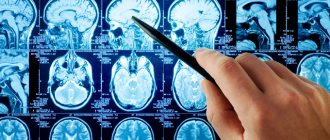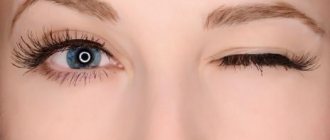Life is in motion. This statement is especially true for young children. After all, the child’s development is judged by the state of their muscle tone and how it develops. The motor activity of a newborn is one of the most important factors determining his state of health.
But what to do when parents notice that their infant’s motor functions are not sufficiently developed? What if, at an appointment with a neurologist, they hear a diagnosis of “motor disorder syndrome” or its accompanying diagnosis – “perinatal lesion of the central nervous system” (PPNS)? Our article will tell you about these diagnoses, the characteristics of their manifestation, diagnosis, and in which cases treatment will be most effective.
Clinical picture
Every person's body has muscle tone from birth. This is a certain muscle tension, thanks to which the position of the body is maintained, its postures and, of course, movements are carried out.
In the womb, the baby’s muscles are in hypertonicity: the little fists are compressed, the legs and arms are brought closer to the body, and this is a normal forced position. After birth, it persists for approximately 3 months, after which the tone returns to normal. In practice, this means that the muscles are not very tense, so you can easily open the child’s palm, bend the legs and straighten them. Movement disorders are spoken of in such situations.
Muscle hypertonicity
A sign that a large number of nerve impulses are coming from the central nervous system. The mother must show the baby to a neurologist in the following cases:
- in a lying position, the child’s body bends in the form of an arc;
- the baby is barely a month old, but he can hold his head perfectly;
- after 3 months, the child does not open his hand to grasp the toy, he always clenches his fists and presses them to his body;
- the head is always turned in one direction;
- if you put the baby on his feet, he rests on his toes, and not on his full foot;
- turns over only on one side;
- under the age of one year, gives preference to one hand (infants should use both their left and right hands equally well).
Massage is effective for muscle tone
With muscle hypertonicity in newborns, motor skills are not formed correctly. After a child learns to walk, disturbances in gait and posture may occur. And since such a condition is just a symptom indicating a pathology of the central nervous system, it can provoke the development of cerebral palsy (CP).
Muscle hypotonia
It occurs when the number of impulses coming from the central nervous system to the muscles is greatly reduced. As a result, muscle tension decreases. Signs of this condition are as follows:
- the baby is lethargic, makes little movements of the arms and legs;
- cannot hold a toy in his hand;
- faint cry;
- baby starts smiling late;
- since the occipital muscles are weak, he cannot hold the head in an upright position for a long time, constantly throwing it back;
- Children with muscle hypertonicity, when trying to sit up at 6-7 months, sway to the sides, it is difficult for them to maintain balance;
- the child does not crawl, does not stand up, does not sit at the appropriate time.
Fitball exercises improve muscle tone
Movement disorder syndrome in the form of muscle weakness negatively affects posture and the spine, and joint dislocations often occur. In severe hypotension, it is difficult for a child to suckle the breast, chew or swallow food independently. There is no manifestation of speech skills for a long time.
Muscular dystonia
A condition in which muscle tone is changeable: either hypertension or hypotonia is observed. Or one muscle group is tense while another is too relaxed.
Movement disorder syndrome: causes, symptoms, diagnosis, treatment, prognosis
- Etiology
- Symptoms
- Diagnostics
- Treatment
- Prevention and prognosis
Movement disorder syndrome (MDS) is a human movement disorder caused by brain damage and disruption of the central nervous system.
It usually affects one or more parts of the brain: the cerebral cortex, subcortical nuclei, brainstem. The form of muscle pathology is determined by the volume and area of brain damage.
The disease is manifested by pathological changes in muscle tone and various motor disorders.
The disease develops in infants 2-4 months old who have suffered trauma or brain hypoxia. The causes of movement disorder syndrome in children may be negative factors that have an intrauterine effect on the fetus and cause perinatal damage to the central nervous system. Convulsive muscle activity, hypotension and weakness require urgent treatment.
SDN clinically manifests itself already in the first days and weeks of a child’s life.
In sick children, hypo- or hypertonicity of muscles occurs, spontaneous motor activity decreases or increases, motor function of the limbs is weakened, and reflex activity is disrupted.
They lag behind their peers in physical development, cannot cope with purposeful movements and their coordination, and have difficulties with hearing, vision and speech. The development of muscle tissue in different limbs occurs at different rates.
These problems gradually provoke mental development disorders and intellectual inferiority. Speech and psycho-emotional development slows down. Children with SDN begin to sit, crawl and walk somewhat later than their peers. Some of them cannot hold their heads up even at one year old.
The complete absence of voluntary movements of the laryngeal muscles in children leads to a violation of the swallowing reflex. This sign indicates a serious stage of the pathology, which requires urgent therapeutic measures that can eliminate such dangerous symptoms.
Since the syndrome does not progress, its timely and correct treatment produces impressive results. According to ICD-10, it is coded G25 and belongs to “Other extrapyramidal and movement disorders.”
Etiology
Etiopathogenetic factors causing perinatal damage to the central nervous system - PPCNS and provoking the syndrome:
- Birth trauma received by a child at birth as a result of the use of physical force by an obstetrician-gynecologist in order to speed up delivery.
- Oxygen starvation (hypoxia) of the fetus leads to damage to brain cells responsible for various muscle processes.
- Difficult and prolonged labor with delayed expulsion of the fetus.
- Intrauterine neuroinfections that penetrate the fetus through the placenta from a sick mother.
- Hidden infections of the mother - rubella, toxoplasmosis.
- Sexually transmitted diseases in a pregnant woman.
- Congenital anomalies of bones and joints.
- Large fetal weight, breech presentation, incorrect insertion of the head.
- Poisoning of a pregnant woman with chemicals or food.
- Genetic causes - chromosomal abnormalities.
- Physical reasons - the effect of an electromagnetic field or x-ray irradiation on the fetus.
- Drug addiction, alcoholism and smoking in a pregnant woman.
- The entwining of the umbilical cord loops around the neck and body of the fetus.
- Fetoplacental insufficiency.
- Hydrocephalus caused by the outflow of cerebrospinal fluid in the brain.
The exact reason in each specific case is not always clear. Typically, the syndrome develops under the simultaneous influence of several negative factors, with one of them being the leading one, and the others only enhancing the effect.
Symptoms
Changes in the normal structure of the brain are manifested by various motor disorders. This is due to a disruption in the transmission of nerve impulses from brain structures to skeletal muscles and the development of a pathological condition in these muscle groups.
Clinical signs of movement disorder syndrome in infants:
- Decreased muscle strength, slow baby movements.
- Muscle hypotonia leads to dystrophic processes and thinning of the limbs.
- Weakening or strengthening of tendon reflexes.
- Paralysis and paresis.
- Muscle overstrain, spasms, cramps.
- Involuntary movements.
- Violation of basic reflexes - grasping and sucking.
- Inability to independently hold the head, lift and bend limbs, roll over, bend fingers.
- Monotonous screaming and crying.
- Articulation impairment.
- Poor facial expressions of the patient, lack of smiles.
- Delayed visual and auditory reactions.
- Difficulty breastfeeding.
- Convulsive syndrome, bluish skin.
Infants with SDN sleep poorly, stare at one point for a long time, and periodically shudder convulsively. They can only turn their head and spread their legs with outside help.
Patients press one arm tightly to the body. With their other hand they move and pick up the rattle. Complete relaxation is often replaced by body tension.
If there are visual dysfunctions, the baby does not reach the right thing on the first try.
Symptoms of hypertension:
- the baby's body bends in an arched manner,
- the baby begins to hold his head up early, pick up toys,
- a sick child presses his clenched fists to his body,
- head turned to one side
- The baby stands on his toes, and not on his entire foot.
Symptoms of hypotension:
- sick baby is lethargic,
- he doesn't move his limbs much,
- cannot hold a toy in his hand,
- screams weakly
- the child throws his head back and cannot hold it for a long time,
- does not begin to crawl, sit and stand up in time,
- does not maintain balance in a sitting position, staggers from side to side.
There are several forms of pathology:
- with predominant damage to the legs - the child moves his arms, “drags” his legs, begins to walk late;
- unilateral damage to the muscles of the entire body with impaired swallowing and speech function, mental retardation;
- disorder of motor functions due to damage to both limbs - inability to crawl, stand and walk;
- complete immobility of the child, mental retardation, mental instability.
If a child has been diagnosed with SDN, it is necessary to act and not despair. When provided with qualified medical care, a child’s body can resist the disease.
It happens that neurologists make mistakes or make a similar diagnosis, playing it safe, especially if the symptoms are subtle. As a result of careful observation of such children, the diagnosis is removed.
The child grows up completely healthy.
Stages of development of movement disorder syndrome:
- The early stage is manifested by impaired muscle tone. Babies 3-4 months old with SDN often do not turn their heads, and babies 5-6 months old do not reach for toys or suffer from seizures.
- The second stage manifests itself with more noticeable signs: patients cannot hold their head up for 10 months, but try to sit down, turn around, walk or stand in an unnatural position. At this time, uneven development of the child occurs.
- The late stage of the syndrome occurs after 3 years. This is an irreversible stage, characterized by skeletal deformation, the formation of joint contractures, problems with hearing, vision and swallowing, impaired speech and psychophysical development, and convulsions.
Normal stages of child development
Internal organs are involved in the pathological process, which is manifested by impaired excretion of urine and feces, disarticulation, and incoordination of movements. The syndrome is often combined with epilepsy, mental and mental development disorders.
Sick children perceive information poorly and have difficulty eating and breathing. In the future, sick children have problems with learning. This is associated with impaired memory and ability to concentrate.
Hyperactive children suffer from restlessness and lack interest in activities.
Timely contact with specialists helps to avoid serious consequences. Late detection of the syndrome complicates the situation. Normal children in the first or second year of life pronounce individual sounds, whole syllables and simple words, but children with SDN only produce incomprehensible whining.
Heavy breathing is accompanied by uncontrolled opening of the mouth, a nasal tone of voice, and the pronunciation of inarticulate sounds.
Disruption of the normal structure of the nervous tissue limits the child’s independence of free movement and only partially preserves the ability for self-care.
Diagnostics
The diagnosis and treatment of the syndrome is carried out by specialists in the field of neurology and pediatrics, who make their diagnosis based on data obtained from the history of pregnancy and childbirth of the mother. The results of laboratory tests, ultrasound, tomography and encephalography are of great importance.
- Perinatal history - intrauterine infection, severe intoxication of the body, oxygen starvation of the brain.
- Assessment of a newborn using the Apgar scale allows you to characterize the vitality of the baby at birth.
- Neurosonography is an examination of a newborn that involves scanning the brain with ultrasound.
- Ultrasound with Doppler - study of cerebral blood flow through the fontanel.
- Electroencephalography is a method for studying the electrical activity of the brain removed from the surface of the scalp, recording such potentials.
- Electroneuromyography is performed to assess muscle tone.
- A CT or MRI scan of the brain can detect lesions.
- Examination by an ophthalmologist, ENT specialist, psychiatrist, orthopedic traumatologist.
Treatment
A child with SDN should be observed by a neurologist and undergo comprehensive treatment. Currently, there are effective techniques that can quickly eliminate the disease. The earlier the syndrome is detected, the easier it is to fight it.
A set of therapeutic measures used for SDN:
- Massage is an effective tool that allows you to achieve excellent results. Before the session, the child is warmed up, and after it, he is wrapped in a woolen blanket. A massage therapist must specialize in working with newborns and infants. After 10-15 sessions, the patient’s condition improves significantly.
- Therapeutic exercise restores motor functions and coordination of movements.
- Osteopathy is an effect on certain points of the body.
- Reflexology is indicated for children with delays in maturation of the nervous system and development.
- Homeopathy activates brain processes.
- Physiotherapy - myostimulation for muscle hypotonia, paraffin therapy, hydromassage, baths, electrophoresis, magnetic therapy.
- Diet therapy - eating foods containing vitamin B.
- Balneotherapy, mud therapy, animal therapy - communication with dolphins and horses.
- Pedagogical correction, special regime and speech therapy techniques.
- Use of auxiliary devices - walkers, chairs, stand-up machines, bicycles, exercise equipment, pneumatic suits.
- Sanatorium and resort treatment in Crimea and on the Black Sea coast of the Krasnodar Territory.
Drug treatment consists of the use of anticonvulsants and muscle relaxants; diuretics; drugs that reduce intracranial pressure; B vitamins; drugs that improve microcirculation in brain tissue; antihypoxants; drugs that tonic blood vessels. Patients are prescribed Cerebrolysin, Cortexin, Ceraxon, Actovegin, Piracetam, Glycine, Neurovitan, Mydocalm, ATP, Proserin.
Surgery for hydrocephalus allows you to restore the outflow of cerebrospinal fluid. Surgeons perform tendon and muscle plastic surgery and remove contractures. In order to correct disorders in the nervous tissue, neurosurgical interventions are performed.
SDN responds well to treatment if it is started correctly and on time. The prognosis of the pathology largely depends on the observation of parents and the professionalism of doctors. If the syndrome is not treated, serious consequences of functional failure of the central nervous system may develop - cerebral palsy and epilepsy, which require longer and more severe therapy.
Prevention and prognosis
Preventive measures to avoid the development of the syndrome:
- protection of motherhood and childhood;
- eliminating bad habits in pregnant women;
- the child’s interest in learning about the world around him with the help of colorful pictures and bright toys;
- barefoot walking, exercise therapy, therapeutic massage, fitball exercises,
- frequent finger play, walking on textured surfaces.
SDD is a treatable disease that needs to be fought. A mild form of the pathology responds well to adequate therapy. More severe cases require a special approach.
If parents do not notice dangerous symptoms and do not consult a doctor in time, the child will have difficulty walking and learning. Advanced forms are complicated by mental retardation and epilepsy.
Any delay in treatment can turn a mild case into a complex process.
Source: https://sindrom.info/dvigatelnyx-narushenij/
Causes
We recommend reading: When do newborns start holding their heads up?
Often children with severe movement disorder syndrome have a history of pathologies of the nervous system that developed during fetal development or during childbirth. That is, muscular dystonia occurs due to damage to the central nervous system (in short, perinatal damage to the nervous system is called PPCNS). Factors provoking the development of pathology:
- Hypoxia is the main cause of brain damage in a fetus or newborn due to disruption of its blood supply.
- Intrauterine infections.
- Birth injuries, which often occur with breech presentation, large fetal weight, and incorrect insertion of the head. In all these cases, damage to the spinal cord may develop.
Stages
According to the tic severity scale, there are 4 stages of the disease:
- A mild degree is sometimes invisible to those close to you. The patient copes well with emotional stress, controls his behavior and can live a full life. Sometimes there are long periods without tics.
- Moderate is more noticeable, the patient cannot completely restrain himself.
- A severe degree practically deprives a person of the ability to control his behavior; he has difficulty existing in society, work and everyday activities are difficult.
- The severe degree is completely uncontrollable, motor and vocal tics are very pronounced, the patient is incapacitated.
Types of speech disorders in Tourette syndrome
Tourette syndrome is characterized by the following speech disorders:
- palilalia - repeated repetition of the same word;
- echolalia - repetition of words and phrases spoken by the interlocutor;
- coprolalia – uttering obscene words (observed only in 10% of cases, and therefore is not a characteristic symptom);
- The volume of speech, its speed, timbre, accents, tone, etc. may change.
Other symptoms of this disease are behavioral reactions, which are expressed in excessive impulsiveness, emotional instability and aggression.
How is the disease diagnosed?
The diagnosis is made by neurologists after a thorough examination. In this case, the perinatal history is taken into account: were there any manifestations of hypoxia, toxic-metabolic disorders, previous infections; Attention is drawn to assessing the condition of the newborn using the Apgar scale.
Neuropsychic development is assessed by month
A child with an open fontanel is required to undergo neurosonography and Doppler examination of cerebral blood flow. In severe cases, it is recommended to do an MRI or CT scan of the brain. Pediatricians and neurologists have tables with the norms for the development of motor and psychomotor skills by month. Based on this table, an evaluative comparison of the achieved results is made.
Diagnosis of the disease
Treatment for Tourette syndrome is prescribed exclusively by a doctor. The diagnosis is made based on the medical history and symptoms. Unfortunately, there is no universal test for diagnosing the disease, so in some cases an electroencephalogram (EEG) or computed tomography may be prescribed. It is also necessary to take a blood test to rule out other diseases.
In addition, since a number of other diseases may be associated with this syndrome, additional research may be required. The most common tests are for attention deficit hyperactivity disorder, depression, and obsessive-compulsive disorder.
Treatment
Recovery methods, that is, treatment, will depend on the severity of the baby’s condition. Medications are prescribed that reduce or improve neuromuscular transmission of impulses.
Treatment with massage, electrophoresis, and physiotherapeutic methods is widely used. They practice exercises on a fitball. The doctor tells parents how to organize proper nutrition. A mother can perform some exercises with her child at home, but only after receiving appropriate instructions.
When does Tourette Syndrome occur?
Most often, Gilles de la Tourette syndrome occurs between the ages of 4 and 10 years. Further, it progresses and without adequate treatment, the condition of patients deteriorates sharply over the years. However, in my medical practice, there have been clinical cases where the first symptoms of Tourette's syndrome appeared at 2–3 years, or at 20–25 years. The peculiarity of Gilles De La Tourette's disease is that for many years it can be in a compensated form and not manifest itself clinically. That is, there are no symptoms, or the child has ordinary tics, which do not particularly bother the parents. But in vain! The best time for treatment is being missed, the disease is slowly but surely progressing! The planet is full of people with tics that, over the years, develop into Gilles De La Tourette Syndrome.
Forecast
The consequences of PPCNSL can be very different, depending on the severity of the damage to the nervous system. In the most problematic cases, epilepsy, mental retardation, and difficulty walking develop. With mild degrees, the child may be hyperactive, have difficulty learning, and have difficulty concentrating and remembering information. Headaches, weather sensitivity, and manifestations of vegetative-vascular dystonia are possible.
Movement disorder syndrome can be treated as effectively as the affected nervous system allows it. However, in most cases, when the diagnosis is made in clinics and there is no persistent hypoxia during childbirth, muscle dystonia returns to normal by the end of the first year of life.
How common is the disease?
Tourette syndrome is much more common than many people think, as it affects approximately 1 in every 100 people.
Symptoms usually begin around age seven and become most severe during adolescence.
Boys are more likely to suffer from Tourette's syndrome than girls. It's not clear why this is so.
Complications
With timely and sufficiently complete treatment, Gilles de la Tourette's disease will not bother the child and his parents. In this case, the patient can lead an active lifestyle and not worry about the progression of the disease.
If the patient does not receive treatment for any reason, his condition may worsen significantly. The risk of developing obsessive-compulsive disorder, sleep and learning disorders, depressive and anxiety states increases.
Related posts:
- Psycho-oncology Psycho-oncology is the science of psychological, mental, social and ethnic…
- Depression and phobias Depression is an insidious disease that has many varieties: endogenous depression,…
- Treatment of schizophrenia without antipsychotics Schizophrenia is a disease that every adult has heard about. Probably,…
- Is it possible to get sick from stress? Stress has become a real problem for humanity; now it’s almost impossible to meet…










